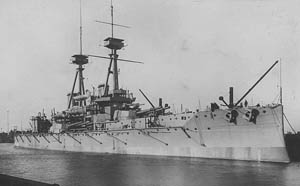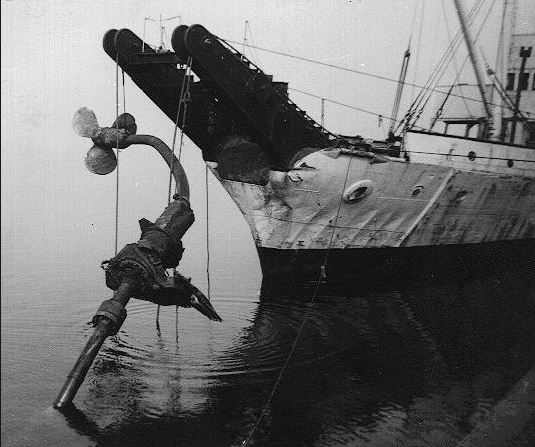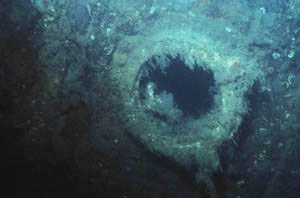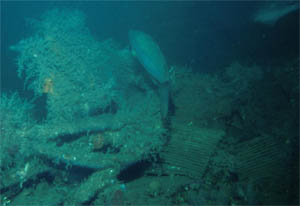HMS Vanguard
58 51 27N, 003 06 21W


HMS Vanguard sank in Scapa Flow on 9th July 1917 with the loss of over 800 lives. The cause of the cordite explosion is unknown to this day and could have been an accident from overheating, spontaneous combustion or sabotage.
After her commissioning she joined the Grand fleet. She was at at the Coronation Fleet review on 24 June 1910 and underwent a refit in 1911.Most of here career was spend carrying out exercises but she was involved at the battle of Jutland and took part is some action against the German Battle Cruisers but its not known if she scored any hits on the enemy.
HMS Vanguard was powered by four Parsons direct drive turbines, driving four shafts. Steam was provided by eighteen Babcock & Wilcox large-tube boilers, with a working pressure of 235 pounds per square inch. The designed Shaft Horse Power (SHP) was 24,500, and the design maximum speed at this SHP was 21 knots. A full fuel load was 2,700 tons of coal and 850 tons of oil, which gave a radius of action of 6.900 nautical miles at ten knots On trials she exceeded her design speed, delivering a speed of 22.1 knots.
The main armament consisted of ten 12-inch Mark XI 50-calibre guns, grouped in pairs in five turrets. There was one turret (“A”) turret on the forecastle on the centreline; one turret on the quarterdeck (“Y”) and one between the after funnel and the after superstructure (“X”), also both on the centreline; and two wing turrets (“P” and “Q”), situated one on either beam just astern of the fore funnel. All turrets except “A” were on main deck level. “A” and “Y” turrets had a field of fire of approximately 270 degrees over the bow and stern respectively. “X” had a field of approximately 100 degrees on either beam. Both “P” and “Q” had in theory a 180 degree field from right ahead to right astern; in practice firing at any angle less than 30 degrees from the keel line produced unacceptable blast damage to the ship’s own superstructure. The Mark XI gun fired a shell weighing 850 pounds, and could fire two rounds per minute, although to allow for the spotting of shell fall one round per minute was more usual. Although ten guns were shipped the lack of any facility for cross-deck firing by “P” and “Q” turrets restricted the broardside to a maximum of eight. The secondary armament at completion of the ship was twenty 4-inch (102mm) 50-calibre QF (quick-firing) Mark III guns in single mounts, distributed in the superstructure and on the roofs of “A” and “Y” turrets. The guns on “A” turret, in spite of being provided with a screen, proved to be badly affected by blast from the nearby 4-inch guns in the forward superstructure, and were removed before the outbreak of the First world war. Extra guns were placed in the forward superstructure, but when later in the war the arming of merchant ships to combat the submarine assault in the Atlantic assumed a high priority, small calibre guns were taken from this and other battleships. In 1917 Vanguard retained thirteen guns of this calibre.[8] Vanguard also shipped four 3-pounder saluting guns. In addition she had three 18-inch torpedo tubes, one on either beam and one firing astern. There is no record of torpedoes being fired in action from this ship.
Vanguard Ordered: 1907
Builder: Vickers Barrow-on-Furness
Laid down: 2 April 1908
Launched: 22 February 1909
Commissioned: 1 March 1910
Class and type: St Vincent Class
Type: Dreadnaught
Displacement: 19,560 t Length: 152.4 m (500 ft) Beam: 25.6 m (84 ft)
Draught: 8.7 m (28.5 ft)
Propulsion: 4 shaft Parsons turbines, coal-fired boilers, 24,500 ship Speed: 21.7 knots (40.2 km/h)
Range: 6,900 nautical miles (12,780 km) at 10 knots (19 km/h) Complement: 758 Armament: 10 × BL 12 inch Mark X1 Guns (5×2) 12 × BL 4 inch Mark X11 Guns 1 × 4 inch AA gun 1 × 3 inch AA gun 3 × 18 inch torpedo tubes (submerged )
The wreck consists of three major sections all of which had substantial damage caused by the explosion. The centre of the wreck stands 15m off the 34m seabed with the bow section being the most complete. The first 15m from the bow look like a ship but from then on its a scrap yard with some ordinance still in there transport mechanisms. The telegraphs were still on the wreck but some salvage was done in the 80’s but hopefully they are still there.
A Buoy was placed over the wreck in the 80’s designating it as a war grave.
This image shows one of HMS Vanguard portholes with the type of growth you can expect in Scapa Flow (Photo – Steve Clarkson taken in 1975)
A similar porthole can be seen in Lyness Museum

The image to the left shows the considerable damage done to the ship with turbine blades separated from the engines in the blast. (Photo – Steve Clarkson taken in 1975)
